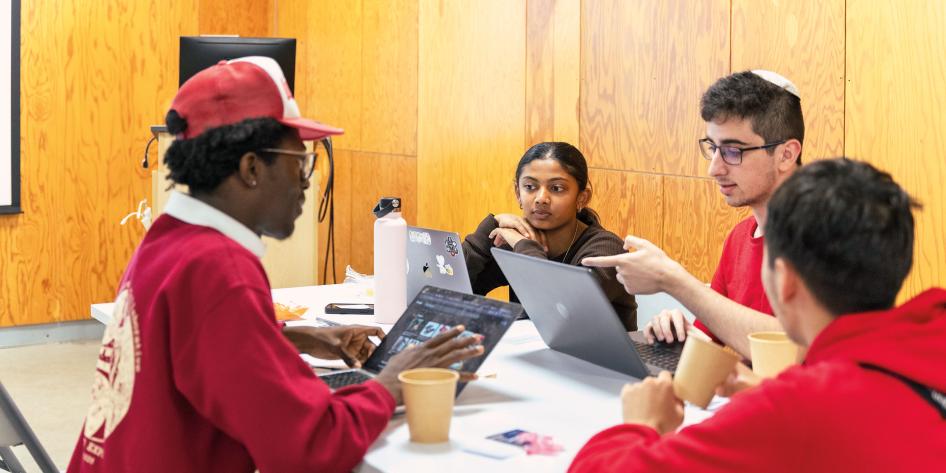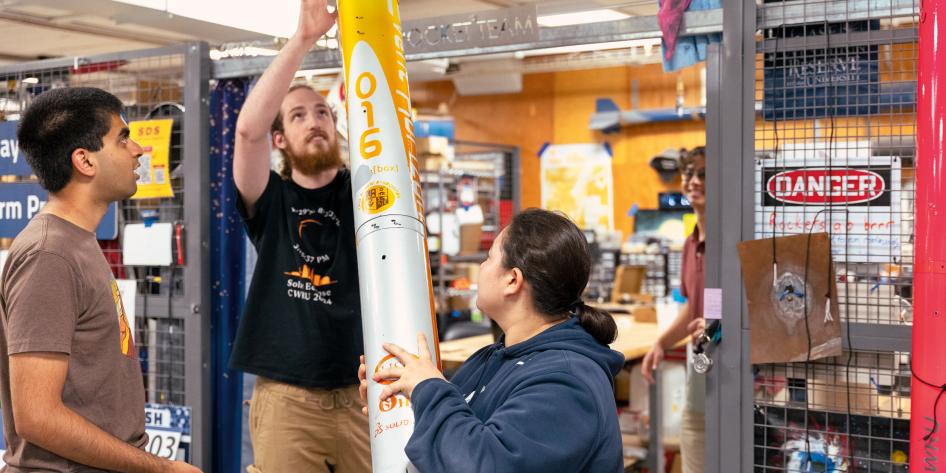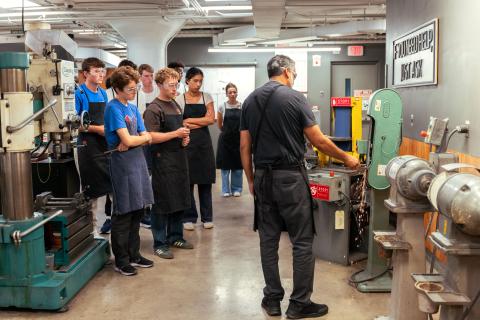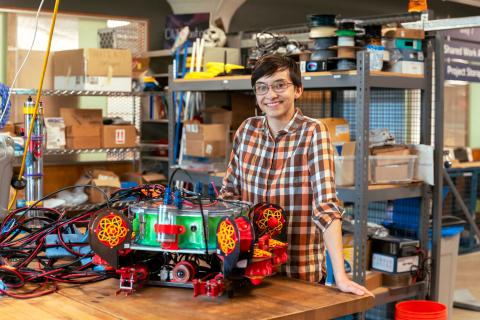From first spark to full flight
Ten years ago, Case Western Reserve University’s makerspace opened its new seven-story home with a bold mission: to make innovation radically accessible to everyone.
Today, the Larry Sears and Sally Zlotnick Sears think[box] is a remarkable success story. Last year alone, it welcomed nearly 81,000 visits from 5,532 campus and community members—including half of CWRU’s undergraduates.
They arrive with questions, ideas, blueprints, or nothing at all. What they leave with is sometimes harder to measure.
“Not everything built here is physical,” said Claire Dorsett, Sears think[box]’s executive director. “Just as often, it’s confidence. It’s resilience. It’s the mindset to keep coming back and trying when something is unfamiliar or hard.”
Open to the public, the fully renovated 50,000-square-foot space in the Richey Mixon Building is the largest university-based innovation center of its kind in the country. That open-access, everything-under-one-roof model—which includes free training and machine time—is unusual. And that helps foster a humming, collaborative environment.
"The whole space is built around access,” said Tiffany Cashon, Sears think[box]’s senior director of strategic partnerships and business development. “If you’ve got an idea and a little curiosity, we’ll help you figure out the rest.”
That approach helped launch dozens of ventures that have collectively raised more than $400 million in new funding from outside investors. But just as often, the real return is the know-how and determination to build what comes next.
![Larry Sears kneels, smiling, holding a remote control with tracks in a space at think[box].](/news/sites/default/files/styles/aside_664x374_/public/2025-10/CWRU-F25-THI011_0.jpg?h=edf8dc7e&itok=ZPoSW1oM)
A longtime Case Western Reserve University trustee and former adjunct professor of electrical engineering, Sears is a steady presence in the innovation center he helped bring to life.
Floor 1: Community and Opportunity
The first floor offers a welcoming entry point and hosts speakers, pitch competitions, and programs for the campus and community. “We designed it so people could see themselves here,” said Ainsley Buckner, the makerspace director.
That includes Cleveland artist Michael Crawford, a longtime Sears think[box] user who works with laser engravers, computer-guided mills and other advanced tools upstairs to produce custom wooden shoeboxes for clients including musician Missy Elliott and actor Chris Rock. Soon after the first floor opened in 2023, Crawford mounted an art show in the gallery there that drew hundreds. He now runs regular programs through his nonprofit, L.O.V.E. (Learning to Overcome Violence and Envy), bringing area youth into the makerspace to teach them to use its tools.
“I didn’t know how to do any of this when I started,” Crawford said. “But I stuck with it—and now I pass on my knowledge to kids who need an outlet for their artistic ideas and creativity.”
For Buckner, that’s the intent: The space “turns access into belonging.”

Campus and community members explore innovation at Sears think[box] through classes, workshops and individual creations, and by participating in pitch competitions and on project teams.

Campus and community members explore innovation at Sears think[box] through classes, workshops and individual creations, and by participating in pitch competitions and on project teams.

Campus and community members explore innovation at Sears think[box] through classes, workshops and individual creations, and by participating in pitch competitions and on project teams.

Campus and community members explore innovation at Sears think[box] through classes, workshops and individual creations, and by participating in pitch competitions and on project teams.
Floor 2: Collaboration and Creative Thinking
On the Wyant Collaboration Floor, ideas sprawl across whiteboards, rough prototypes cover tables, and users huddle in loose circles. The floor also supports everything from summer camps to ceramics club meetups. It’s a bright, flexible space full of materials to help people begin figuring out what to build and how.
Each semester, students use the floor to tinker, experiment and collaborate—whether on their own or in courses that treat the space as a classroom. In the introductory engineering course “Foundations of Engineering and Programming,” for example, students work on increasingly challenging hands-on projects, often with few directions.
“That’s the point,” said Kurt Rhoads, PhD, an associate professor at Case School of Engineering who directs the Roger E. Susi First-Year Undergraduate Engineering Experience. “Engineers deal with unknowns. They have to make something out of ambiguity.”
Toward the end of each semester, students design and race vehicles equipped with biologically inspired “whegs,” which are wheel-leg hybrids meant to mimic how animals move.
The competition unfolds over an obstacle course at Sears think[box] that blends clever design with pure spectacle.
“It’s hilarious and fun,” Rhoads said. “But it’s also real engineering. Students are solving problems, testing ideas—and they’re having a blast doing it.”
Floor 3: Prototyping and Possibility
On the Prentke Romich Floor, ideas start taking form with the aid of student technicians who help hundreds of visitors annually. The floor hums with 3D printers, vinyl cutters, soldering irons, embroidery machines and rows of laser cutters.
Some projects result in the creation of practical tools. Others evoke entire worlds, as students build scale models for theatrical productions with foam core, matte board, plywood and filament.
Jill Davis, MFA, an associate professor of theater, remembers when her approach to teaching scenic design changed. A student in a class mentioned his plans to cut model pieces at Sears think[box].
Curious, Davis visited. “I saw what was possible,” she said. “And I thought, ‘Why aren’t we all doing this?’”
Now, the makerspace is a cornerstone of her “Scenic Design” course. Each semester, students create two miniature sets using precise cutting tools and 3D-printed details like tiny staircases.
“It gives them the tools to experiment, push boundaries and see themselves as real designers,” Davis said.
Davis and her students have also used the makerspace to fabricate props and architectural elements for productions. One student even 3D-printed monkey-shaped wall sconces as a cheeky stage detail for The Drowsy Chaperone.
“Design isn’t just about filling space,” Davis said. “It’s about shaping the emotional world of a play; think[box] gives us the tools to build that world.”
Floor 4: Fabrication and Realization

The Lubrizol Foundation and Kent H. Smith & Kelvin Smith Fabrication Floor is home to advanced, heavy-duty equipment for woodworking, metalworking and welding. Hundreds of undergraduate engineers come to the floor annually for a rite of passage: They make a hammer to learn the fundamentals of fabrication.
For Rucha Batchu, who graduated in May, it also became a creative and intellectual home. She began as a third-floor prototyping technician, but with support from staff and peers, Batchu started working with the fourth floor’s industrial tools, eventually building furniture for her home.
“I like projects that feel like puzzles,” said Batchu (CWRU ’25; GRS ’25, mechanical engineering). “And think[box] gave me the space to figure them out.”
She used that freedom to pursue a master’s-degree project: designing and building a treadmill for small robots as a way to better understand animal movements.
That spirit of exploration also shaped her work as a teaching assistant for an introductory engineering course, where she watched students go from intimidated to excited. “Some people walk in thinking they don’t belong in a [shop] space,” she said. “But once they build something—even something small—you can see it click. They want to do more.”
Floor 5: Project Space and Precision
From rockets and off-road vehicles to remotely operated underwater robots, student design and competition teams create ambitious projects on the Eric T. Nord Project Space Floor. With dedicated bays, long-term storage and access to tools across the floors, it offers the space to build, test, fail and try again—together.

For Amitan Bar-Evan, a third-year mechanical engineering student and president of the CWRUbotix student robotics club, the fifth floor is where ideas come to life. She and her teammates spend months designing, machining, assembling and refining their robots—including a fully submersible ROV (remotely operated vehicle) that earned first place in the Explorer Class at the international 2025 MATE ROV World Championship, besting 26 teams from other universities.
“We built the whole thing from scratch … spending hours machining parts and then testing buoyancy, pressure seals and balance in campus pools,” she said. “Each time something didn’t work, we’d figure it out at think[box].”
Floor 6: Entrepreneurship and Impact
Officially named the Cloud L. Cray Jr. and Sally Hunter Cray Center for Venture Creation, the sixth floor supports several CWRU startup resources, including the Sears think[box] expert-in-residence program and workshops led by LaunchNET and the Veale Institute for Entrepreneurship.
“At Sears think[box], students don’t have to go far to connect,” said Michael Goldberg, the Veale Institute’s executive director. “What starts as a casual conversation can turn into a prototype, a pitch or a path forward.”
For Ignas “Iggy” Kamugisha, the environment supported—and expanded—his vision. Before coming to CWRU, the native of Tanzania created an organization called teKsafari to broaden access to computer science education in Swahili. He initially traveled from one village to another, bringing laptops to rural schools.
“But when we left,” he said, “the momentum left, too.”
Then he discovered Sears think[box] online—and that’s why he applied to Case Western Reserve. “I knew I needed a place like this,” he said. “A place where people could experiment, learn and belong.”
Kamugisha quickly immersed himself in the Sears think[box] ecosystem—volunteering, prototyping, leading tours and later working as a student technician.
“People were helping each other, learning together,” said Kamugisha, now a third-year student. “It made me ask: Why can’t we have this where I’m from?”
With guidance from campus mentors and backing from foundations, Kamugisha created thinkStudio—a makerspace in Tanzania inspired by Sears think[box]. It opened last year in a renovated house and offers access to 3D printers, laptops, mentorship and a sense of belonging.
“We’ve seen students go from never using a computer to getting scholarships abroad,” he said. “That’s the kind of transformation we want—where opportunity doesn’t depend on luck.”
Floor 7: Incubation and Ascent
On the top floor, entrepreneurial ambition takes shape. Home to the Sears think[box] business incubator and Veale Institute for Entrepreneurship, the space offers dedicated offices and access to the six floors of tools and talent below.
The incubator has supported more than a dozen ventures mainly led by students, faculty or alumni. Many draw funding from public and private sources. Collectively, they’ve created nearly 100 paid positions for CWRU students and alumni.
One of the most visible successes is Path Robotics, co-founded by brothers Alex Lonsberry (CWRU ’09; GRS ’12, mechanical engineering) and Andrew Lonsberry (GRS ’21, mechanical engineering).
They began creating their artificial-intelligence-powered robotic welding systems on the lower floors of Sears think[box], then spent nearly two years in the incubator refining key components: optical sensors, computer vision models and robotic controllers. They had room to test, fail, iterate—and eventually win their first industrial contract.
![A person in a Sears think [box] jacket stands behind a geometric frame mounted with cameras.](/news/sites/default/files/styles/large/public/2025-10/CWRU-F25-THI09_0.jpg?itok=gmU2PCYu)
“think[box] gave us our own space, the tools, the software—the foundational stuff we couldn’t have afforded otherwise,” Alex Lonsberry said. “We created the first version of everything there.”
That foundation proved catalytic. Now based in Columbus, Path Robotics has raised more than $300 million in venture funding and employs more than 170 people—including five other CWRU alumni. Its autonomous welders are deployed across North America in infrastructure, transportation and energy manufacturing settings, and the company is expanding into international markets.
“Without think[box], we would not be where we are today,” Alex Lonsberry said.
It’s that CWRU-nurtured environment—ambitious, collaborative and hands-on—that defines Sears think[box].
“Everyone here is building something different,” Dorsett said. “But what unites them is a willingness to experiment, take risks, fail and keep going. They’re chasing progress, not perfection—and that’s where the magic happens.”
Photographs by Daniel Lozada

